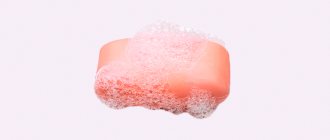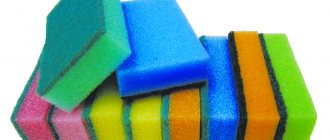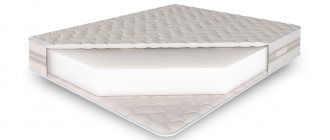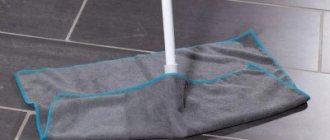It's no secret that kitchen rags and sponges are one of the dirtiest items in the house; in terms of the degree of contamination with microbes, they easily surpass even toilet rims. However, not all housewives agree to poison themselves and loved ones with bleach, so they successfully use other, less allergenic methods of disinfection. With their help, you can significantly extend the life of towels, rags and sponges, and therefore save on their purchase.
Soaking with vinegar
To ensure that the rag always smells nice and looks neat, it is recommended to sometimes soak it in 5% vinegar. You can buy such a ready-made solution or prepare it yourself from 70% essence. It is enough to hold the fabric in it for about 10 minutes and then rinse.
This treatment will protect the fibers from mold that may occur due to dampness. You should not keep kitchen utensils in the solution for too long, since acetic acid affects the strength of the material.
Boiling
Boiling is a proven “grandmother’s” method for returning a pleasant aroma to kitchen towels. Before boiling, you should separate the products into colored and white to avoid molting of flowers.
You can simply boil the towels for about 1 hour in a saucepan, then put them in the washing machine and wash them again at a temperature of 60-90⁰C without adding any products. But after treatment with boiling water alone, the product will become more rigid compared to its original state.
To avoid this, there is another option: boiling. A large 12-15 liter saucepan is filled halfway with cold water. Then you need to add the following components:
- half a glass of soda;
- four tablespoons of hydrogen peroxide;
- any oxygen stain remover;
- half a piece of laundry soap 72%, grated on a coarse grater.
Mix everything thoroughly and put towels in the pan. Then add more cold water, not reaching the edge of the container by 5-6 cm. Put everything on the fire and wait for the water to boil.
After the water boils, simmer for at least 45 minutes. Remove the boiled products from the pan and place them in the washing machine. Add table vinegar and water in equal parts to the air conditioner compartment. Wash on boiling cycle. After this treatment, the laundry will be soft and fluffy.
Thus, with the right choice of method for washing kitchen towels, the problem of unpleasant odor can be easily dealt with.
Washing machine as a source of stench
The washing machine also requires maintenance. Otherwise, it will be the same distributor of unpleasant odors that will permeate clean linen. After each wash, the water should completely drain from the machine drum. If this does not happen, then mold will most likely form there. The rubber gasket around the washing machine door should also remain dry and clean. It should be cleaned periodically with soapy water, wiping all folds well. After each wash, the machine door must be opened for ventilation, as well as the room itself where the unit itself is located.
The powder tray should be washed to remove any remaining detergent. It needs to be dried by pushing it out.
Once every 3 months, an empty washing machine must be run at maximum temperature with citric acid or vinegar. This is how the filters of the device are cleaned.
What to do and how to get rid of the smell at home?
Nobody wants to use towels that have a not particularly pleasant aroma. But this is not a reason to throw them away.
Some time-tested folk recipes will help you cope with the problem . As a result, textiles acquire pristine purity and freshness.
Re-wash
Sometimes it is enough to re-wash the towels in hot water with double the dosage of washing powder. This will eliminate the bacterial microflora. It is not recommended to add conditioner.
Vinegar
Vinegar is considered a universal means for disinfecting linen.
Before washing, towels are soaked for half an hour in the following solution: 200 ml of table vinegar diluted in 8-9 liters of water . You can replace vinegar with citric acid, in the amount of 2-3 tbsp. spoons for the same volume of water.
Another option is not to soak the textiles, but after completing the main cycle when washing in a machine, add vinegar or citric acid to the special compartment and run another rinse.
The source of the unpleasant odor from washed clothes may be a dirty washing machine filter . Therefore, you should clean it at least once a month. To do this, pour vinegar into the drum, set any mode and turn on the machine (without adding laundry).
Instead of the usual detergent, use baking soda, or in combination with vinegar. It is poured into the compartment of the automatic machine (30 g is enough). Vinegar, diluted with water in equal proportions, is poured into the rinsing cell.
Boiling
Boiling helps solve the problem of unpleasant odors from washed towels, but not all fabrics are suitable for this procedure. So, terry products become tough. But you can correct the situation with the help of a good air conditioner.
If you resort to the old method of boiling, then they act like this:
In the case of machine washing, select the highest temperature mode with a long time interval.
Only towels made from natural fabrics are allowed to boil. Even colored textiles will not fade if they are of high quality .
Bleaching powder
Bleach has always been used as a powerful antiseptic. But it should be used wisely.
How to proceed to give your towels a fresh scent:
If you want to use bleach in the washing machine, you cannot add the product undiluted. The exception is tablets that can be placed directly into the laundry drum.
Liquor
This option is more suitable for village residents, which is due to the technology for preparing lye:
Since lye does not have cleansing properties, towels boiled with it must then be washed.
This ancient remedy is completely washed out when rinsed, unlike modern powders and gels . As a result, the textile becomes soft and fragrant.
Microwave
A microwave will help in the fight against unpleasant aroma. Towels are placed in it for 30 seconds, then washed. As a result of such a maneuver, not a trace will remain of the stench.
This article will tell you about washing towels in the microwave.
Special fragrance removers
Nowadays, all kinds of household chemicals are available for sale, including odor eliminators. Here are the most effective:
I came up with a simple but effective way to prevent kitchen rags from smelling. I share with you
Hi all! Today I will show you how to easily get rid of the unpleasant smell of a dishcloth without long soaking, boiling and the use of dangerous chemicals.
Sooner or later, kitchen rags begin to emit an unpleasant musty smell. This occurs as a result of the activity of bacteria formed from the remains of fat, food and dampness.
During normal washing, bacteria remain inside the rag. Thus, at the first contact with biological products and water, they begin to actively multiply again, emitting a foul aroma.
But if it’s easier to throw away a sponge for washing dishes and replace it with a new one, then throwing away a kitchen cloth every time it smells is very uneconomical.
To get rid of this unpleasant odor, it is not necessary to resort to special disinfectants containing chlorine-containing substances that are hazardous to health.
I've come up with a clever way to help give new life to your dishcloths! I do this:
I generously wet a kitchen cloth. I apply dishwashing detergent. Wrinkle until foam appears.
Next, I put the cloth on a plate and put it in the microwave for 2 minutes, at maximum power.
Once the 2 minutes are up, I take out a plate with a cloth and let it cool a little. Next you need to rinse it properly. And dry it.
By heating a wet cloth in a microwave oven, we sterilize it with steam, thereby killing bacteria. After the cloth dried, not a trace remained of the smell.
I carry out this procedure as soon as I feel a slight smell again. Now you know how to deal with it!
Source
Where does it come from?
The cause of the stench can be different; just leave a damp towel after a shower, and mold will appear on it after a while.
Wet things are a breeding ground for bacteria. If you do not dry them in time, an unpleasant stench will appear, which appears due to the rapid proliferation of harmful microorganisms that poison the lives of household members.
Why does a towel smell bad?
- the washing machine does not wipe dry, bacteria collect and multiply in places that are difficult for a woman to reach, mold forms and spreads to things;
- long-term use of towels;
- increased humidity in the place where things dry;
- the wrong washing mode is set;
- the towel is not completely dry;
- poor quality material.
If your towels stink after washing, you should first eliminate all these factors. Even one of them can cause a stench, after which terry or other textile material cannot be reused.
Every housewife should know how to wash towels if an unpleasant odor appears. Eliminating the problem is possible using folk methods or purchased products.
Bringing back freshness: what to do if towels smell unpleasant after washing?
Many housewives often wonder why only washed towels do not smell fresh at all.
In fact, this phenomenon is not uncommon, since towels are a real breeding ground for bacteria. This is due to the fact that kitchen towels strongly absorb food odors, and bath towels absorb moisture.
To avoid this problem, you should approach the washing and drying process correctly, and also listen to a number of useful recommendations. This will be discussed in the article.
Thorough rinsing and drying
In order to initially prevent the appearance of an unpleasant odor, do not forget that after washing dishes or cleaning the kitchen, the cloth also needs to be washed. The fibers of the fabric and the pores of the sponge accumulate fat, household chemicals, crumbs and other food residues, which, in turn, are the reason for the appearance of a characteristic amber in kitchen assistants. But rags that are thoroughly washed and dried after use do not smell.











